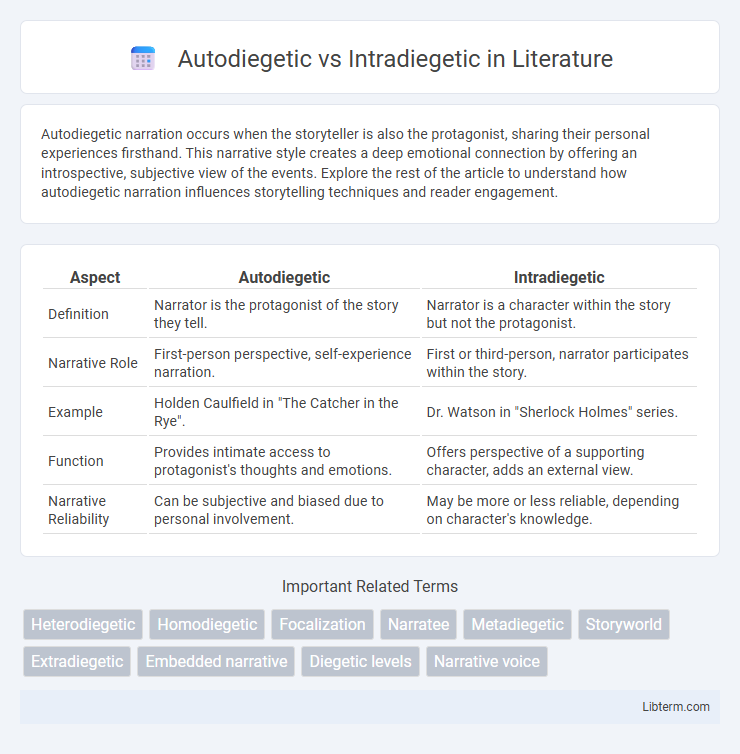Autodiegetic narration occurs when the storyteller is also the protagonist, sharing their personal experiences firsthand. This narrative style creates a deep emotional connection by offering an introspective, subjective view of the events. Explore the rest of the article to understand how autodiegetic narration influences storytelling techniques and reader engagement.
Table of Comparison
| Aspect | Autodiegetic | Intradiegetic |
|---|---|---|
| Definition | Narrator is the protagonist of the story they tell. | Narrator is a character within the story but not the protagonist. |
| Narrative Role | First-person perspective, self-experience narration. | First or third-person, narrator participates within the story. |
| Example | Holden Caulfield in "The Catcher in the Rye". | Dr. Watson in "Sherlock Holmes" series. |
| Function | Provides intimate access to protagonist's thoughts and emotions. | Offers perspective of a supporting character, adds an external view. |
| Narrative Reliability | Can be subjective and biased due to personal involvement. | May be more or less reliable, depending on character's knowledge. |
Introduction to Narrative Perspectives
Autodiegetic narration involves a narrator who is both the protagonist and the storyteller, offering a personal and immersive perspective within the narrative world. Intradiegetic narration refers to a narrator who exists inside the story but may not be the main character, providing insights within the narrative frame. Understanding these narrative perspectives enhances comprehension of storytelling techniques and how characters shape the audience's engagement with the plot.
Defining Autodiegetic Narration
Autodiegetic narration occurs when the narrator is also the protagonist of the story, providing a first-person perspective that offers intimate insights into their experiences and emotions. This narrative mode allows the audience to access the protagonist's internal thoughts and subjective interpretations, creating a deeper emotional connection. In contrast, intradiegetic narration includes any narrator who exists within the story world but is not necessarily the central character, offering different levels of proximity to the main events.
Understanding Intradiegetic Narration
Intradiegetic narration occurs when a story is recounted by a character who exists within the narrative world, providing insights and perspectives limited to their experiences. This form of narration enriches the narrative by offering subjective viewpoints and deepening character development through firsthand accounts. Understanding intradiegetic narration is essential for analyzing character reliability, narrative bias, and the interplay between narrator and audience in literary and cinematic studies.
Key Differences Between Autodiegetic and Intradiegetic Narrators
Autodiegetic narrators are characters who tell their own story, providing a first-person perspective within the narrative, while intradiegetic narrators exist inside the story but do not necessarily act as protagonists. The key difference lies in involvement: autodiegetic narrators participate directly in the events, often revealing personal thoughts and feelings, whereas intradiegetic narrators may describe events affecting other characters without being the central focus. Understanding this distinction is crucial for analyzing narrative perspective and character engagement in literary works.
Narrative Levels: Diegesis Explained
Autodiegetic narrators are characters who tell their own story from within the narrative, providing a first-person perspective that blurs the line between narrator and protagonist. Intradiegetic narrators exist within the same diegetic level as the story they recount, offering insight into events from inside the narrative world without being the central character. Understanding these narrative levels clarifies how diegesis functions, distinguishing between stories told by characters within the world versus external or multi-layered narrative structures.
Examples of Autodiegetic Narratives
Autodiegetic narratives feature the protagonist as the narrator, offering a personal and subjective recounting of events, exemplified in classics like "The Catcher in the Rye" by J.D. Salinger where Holden Caulfield narrates his own story. Another notable example is "Jane Eyre" by Charlotte Bronte, with Jane providing a first-person perspective that reveals her inner thoughts and experiences. These narratives enhance reader engagement by creating an intimate connection between narrator and audience, distinguishing them from intradiegetic narrators who tell stories about others within the story world.
Examples of Intradiegetic Narratives
Intradiegetic narratives occur when a character within the story's world becomes the narrator, offering a firsthand perspective that shapes the audience's understanding of events. Classic examples include Nick Carraway in F. Scott Fitzgerald's "The Great Gatsby," whose observations and personal reflections guide the narrative. Similarly, the protagonist's narration in Charlotte Perkins Gilman's "The Yellow Wallpaper" provides an intimate glimpse into her psychological descent, demonstrating how intradiegetic narration enriches character depth and storytelling.
Functions and Effects in Storytelling
Autodiegetic narrators, who tell their own story, create deep emotional engagement by offering intimate insights into personal experiences and subjective realities, enhancing character development and reliability perceptions. Intradiegetic narrators function within the story world but narrate other characters' events, providing a broader perspective and enabling varied interpretations of the plot and themes. These narrative positions influence readers' alignment and interpretive frames, shaping suspense, bias, and narrative credibility in storytelling.
Impact on Reader Engagement and Interpretation
Autodiegetic narrators, who tell their own story from a first-person perspective, create a deeply personal and immersive experience, enhancing reader engagement through emotional connection and subjective insight. Intradiegetic narrators, positioned within the story but narrating events of others, offer a more comprehensive viewpoint, allowing readers to interpret multiple perspectives while maintaining a coherent narrative framework. The choice between autodiegetic and intradiegetic narration directly influences how readers perceive reliability, intimacy, and overall interpretation of the story's themes and characters.
Conclusion: Choosing the Right Narrative Voice
Selecting the appropriate narrative voice depends on the story's perspective and emotional depth. Autodiegetic narrators offer intimate, first-person accounts that reveal personal experiences and biases, enhancing character-driven narratives. Intradiegetic narrators provide a more external viewpoint within the story world, allowing for versatile storytelling that can include multiple perspectives and broader context.
Autodiegetic Infographic

 libterm.com
libterm.com